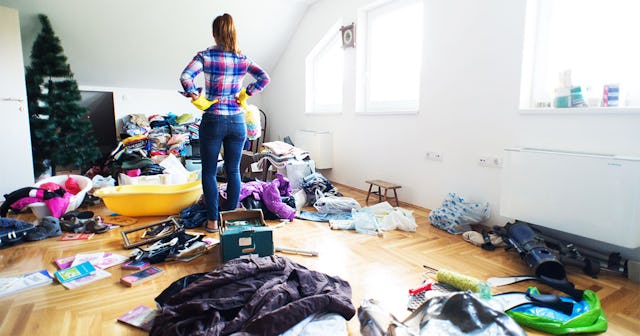How To Declutter Your Home ASAP Before The Holiday Season

‘Twas the month before Christmas, and all through your house, there’s a crap-ton of stuff. If this about sums up your life, you’re probably feeling a desperate need to de-clutter and organize before the holiday hits. Otherwise, you’ll be even more overwhelmed and either give up or rage clean and toss—neither of which is going to result in the home you want.
Look no further. Home organizers Jennifer Barton and Jami Cohen, co-owners of NEAT Method St. Louis, are here to help. They understand just how desperate we feel when our houses are closing-in with clutter. I asked them in an interview, how can we get our homes in order before the holiday season? Thankfully, they’ve got us covered.
Find your motivation.
Why do you want to declutter and organize your home before the holidays? Perhaps you’re hosting this year, and you don’t want your guests to sit between piles of junk. Maybe you’re craving a more minimalist approach, something that’s touted on social media. If you’re like me, you know that the holidays means more stuff, and adding that to what you already have at home is overwhelming. Barton and Cohen want us to know that preparing our homes for the holidays “doesn’t simply mean putting up the tree and lighting the pine scented candles. Clutter-free spaces before the holidays will provide you with a sense of calm amidst the chaos.” What is your “why”?
First up, empty.
Barton and Cohen want us to “take everything out and make sure all items are visible.” Whoa. Everything? Start with one room or one space—like that coat closet that certainly doesn’t hold coats anymore. Put an old sheet on the floor, and get all your stuff out on it. I repeat—all of it. I personally love this tip, because this is part of my motivation. Looking at the empty space—say the closet—and seeing what it can be, is the kick in the butt I need to not put all the stuff back in the space.
Now, it’s time to sort.
Put each item into one of three categories. One pile is for keeping. These are the items you can’t do without. They must be functioning and “have all their working parts.” Another pile is for “toss” items. If an item is “broken” or has “missing parts,” it’s time to make like Elsa and let them go. Your third pile is for donations. These are items you’ll take to a charitable organization or re-sale shop (if you plan to sell them.) You have to decide if you have time to mess with selling. For me, I like to utilize selling in local Facebook groups versus taking my items to a store. You’ll be shocked what others will buy. Plus, you make some extra cash for the holidays!
Categorize your keep pile.
One mistake people make is over-categorizing. Barton and Cohen suggest that we have a bin for all-things-transportation-toys, for example. It’s too cumbersome (and impossible for kids) to divide up toy vehicles by type. Don’t make “clean up time more consuming” than it needs to be. They recommend storing toys, for example, in “soft, woven baskets with handles” since they are “more durable and less likely to damage.” You can label bins and baskets with word or picture labels to help children. Plus, the reality is, as Pinterest-worthy as those color-coded Lego sorting systems are, the kids just end up mixing all the Lego pieces together. Don’t waste your time over-sorting.
Organize it yourself, or teach the kids to help.
Should a parent tackle the home organizing themselves or involve the fam? It’s usually easier for one individual—the adult—to do the project themselves. It’s going to be less painstaking and faster. However, if you want to teach your kids a lesson, they can help with sorting and hauling. They can also help create labels. They can also help move items to the donation center of your choosing. For my family, I find that my older kids can be helpful in choosing which pile to put items in. While my younger and more active children are more likely to haul out the trash or recycling.
When in doubt, hire a professional.
Organizing isn’t everyone’s cup of tea. That’s why there are plenty of home organizing professionals, like Barton and Cohen, whom a person can hire. Barton and Cohen say that in order to find the right person for the job, “ask for pictures of previous spaces” the person has organized. Also, ask for references. View their previous jobs on social media. “Spaces should not only be functional, but aesthetically pleasing,” they share. Yes, there are tons of pretty pictures out there, but if the space looks unreasonable for your family, it doesn’t make sense to pay for the service.
Keep in mind, this won’t be your last organizing session.
We all intend to declutter and then keep a minimalist, well-organized household, but that rarely happens—especially not with children. Cohen and Barton shared with me that “organizing is never one and done.” That it is a “habit like exercise.” At minimum, we’ll have times when we need to “touch up.” However, once we get a “system in place,” future jobs aren’t as overwhelming. If you’ve created a system that doesn’t work, don’t be afraid to “rethink it,” they share.
I don’t know about you, but I am breathing a sigh of relief. It is possible to have a tidier, less-cluttered home before the holidays. If I can set aside a few weekend afternoons, I can ditch the excess just in time to decorate the Christmas tree.